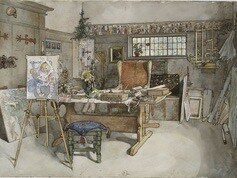Carl Larsson is an iconic Swedish Artist. If you travel to Sweden, you will find the reproduction of many of his prints and artwork on various products. He is like the Norman Rockwell of Sweden as he painted so many wonderful scenes from Swedish daily life in a way no one else has since.
Carl Larsson was born into dire poverty but raised himself out of poverty through his artwork. He married Karin Bergöö, a fellow artist. Together they had eight children. Many of his most famous paintings come from the many family scenes he painted of his wife and children in their home in Sundborn, Sweden. Through his paintings and their home design, Carl and his wife Karin influenced Swedish art and design. Today you can visit their house and garden in Sundborn. Sweden.
Table of Contents
- 22 Enlightening Facts About Carl Larsson: Sweden’s Celebrated Artist and Illustrator
- Fact 1: Carl Larsson Was Born Into Dire Poverty
- Fact 2: His Father Was A Drunk and Loveless Man
- Fact 3: At age Thirteen, He Applied to The Royal Swedish Academy of Arts
- Fact 4: He Earned Enough to Support His Parents
- Fact 5: Studied in Paris
- Fact 6: Joined a Swedish Artistic Colony Outside Paris
- Fact 7: Carl and Karin Had Eight Children
- Fact 8: His Children Were Used As Models For His Artwork
- Fact 9: His Wife Karin Was An Interior Designer
- Fact 10: Karin Acted As Carl’s Art Critic
- Fact 11: The Larssons Were Given A House in Sundborn, Sweden
- Fact 12: Karin Larsson Influenced Swedish Interior and Textile Design
- Fact 13: Carl and Karin Worked Together On Their Home Design
- Fact 14: Carl Larsson’s Popularity Increased With The Colored Printing Press
- Fact 15: His Books Became Very Successful
- Fact 16: Carl Larsson Considered His Most Important Work To Be In Public Spaces
- Fact 17: Carl Larsson was Bitter Over the Rejection of the Midvinterblot Painting
- Fact 18: Midvinterblot’s Controversy Continued for Years.
- Fact 19: Paintings of His Family Are His Life’s Work
- Fact 20: Carl Larsson Suffered From Depression and Other Medical Problems
- Fact 21: His Work Is Representative of the Arts and Crafts Movement.
- Fact 22: You Can Visit the Carl and Karin Larsson Home
- Deep Dive Podcast
- Frequently Asked Questions About the Swedish Artist Carl Larsson
- Related Questions
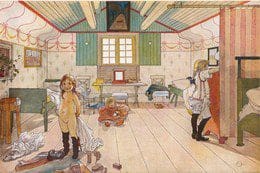
22 Enlightening Facts About Carl Larsson: Sweden’s Celebrated Artist and Illustrator
Emerging from the clutches of severe poverty, Carl Larsson charted a path to artistic prominence with his innate talent. His life took a collaborative turn upon marrying Karin Bergöö, an artist in her own right. The couple, blessed with eight children, became the heart of Larsson’s artistic universe.
Their home in Sundborn, Sweden, frequently featured in his renowned family-centric paintings, encapsulates the essence of domestic bliss and warmth. Carl and Karin Larsson’s artistic synergy extended beyond the canvas, significantly influencing Swedish art and interior design.
Today, their Sundborn residence, adorned with gardens, stands as a testament to their artistic legacy, welcoming visitors to witness the cradle of their creative journey.
Here are some of our favorite facts about the amazing Swedish Artist Carl Larsson and his wife, Karin Bergöö Larsson.
Fact 1: Carl Larsson Was Born Into Dire Poverty
Carl Larsson was born in 1853 in Gamla Stan (Old Town) of Stockholm 1853. His family was impoverished, and his childhood was not very happy.
The family was said to have lived in many places filled with filth and squalor. They would live where maybe three or four families would live together in tiny and tight quarters. These homes were filled with a lot of diseases as cholera.
In speaking of his childhood and growing up, Renate Puvogel, in her book Carl Larsson wrote:
“His mother was thrown out of the house, together with Carl and his brother Johan; after enduring a series of temporary dwellings, the family moved into Grev Magnigränd No. 7 (later No. 5) in what was then Ladugårdsplan, present-day Östermalm”
Renate Puvogel
By all accounts, Carl Larsson’s mother seems to have been a good woman. She worked very hard as a laundress to try to help provide for the family. But despite this, their circumstances were challenging.
Fact 2: His Father Was A Drunk and Loveless Man
His father was a day laborer and sailor. Larsson would later describe his father as a loveless man who lacked a lot of self-control. His father would rant and rave and was said to have lifelong anger toward his son.
Carl Larsson’s father was said to have said to Carl:
“I curse the day you were born.”
carl larsson’s father

Fact 3: At age Thirteen, He Applied to The Royal Swedish Academy of Arts
At the age of thirteen, his teacher at his school for poor children encouraged him to apply to the Royal Swedish Academy of Arts. He was accepted into the Academy. During his first few years at the Academy, Carl Larsson felt socially inferior and shy.
Fact 4: He Earned Enough to Support His Parents
At sixteen (1869), Carl Larrson was promoted to the Antique School at the Royals Swedish Academy of Art. This finally gave him some confidence, and he became a central figure in the student life at the Academy.
Carl earned his first medal at the Academy with some of his nude drawings. He was also working as a caricaturist for the Swedish paper Kasper and as a graphic artist for the newspaper Ny Illustrerad Tidning. He was also working as a part-time illustrator of books and magazines. His annual wages allowed him to be able to support his parents financially.
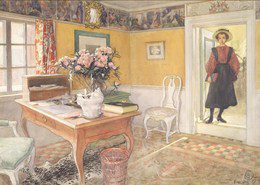
Fact 5: Studied in Paris
In 1877, Carl Larsson was financially successful enough to move to Paris to further his studies and his art. It was said that he spent several frustrating years as an artist without much success. Though impressionism was the movement in Paris, Carl Larsson was not eager to be part of that movement and did not associate with the impressionist movement.
Fact 6: Joined a Swedish Artistic Colony Outside Paris
Carl Larsson spent two summers in Barbizon, France. It was in Barbizon that many of the impressionists and other Plein-air painters were located.
In 1882 he settled in Grez-sur-Loing near Barbizon in a Scandinavian artist colony in France. It was in this Scandinavian artist colony that he met his wife, Karin Bergöö. Karin was also a Swedish artist and designer.
During this time of his life, his painting works also changed as he also started to work in watercolor, which was a lot different than the oil painting techniques he had been using.
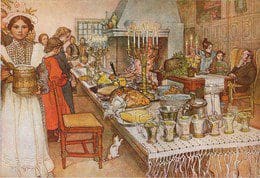
Fact 7: Carl and Karin Had Eight Children
Carl and Karin fell in love, returned to Stockholm, and were married in 1883. They moved back to Grez-sur-long France and stayed there a year when their first child Suzanne was born in 1884. The following year in 1885, they returned to Sweden.
The Larsson eight children are Suzanne (b.1884), Ulf (b1887), Pontus (b.1888), Lisbeth (b. 1891), Brita (b.1893), Mats (b.1894). Kersti (b.1896) and Esbjorn (b.1990).
Fact 8: His Children Were Used As Models For His Artwork
With such a large family, Carl Larsson had many models he could use for his paintings. Many of his paintings feature his children or other friends and family. He painted many paintings of his wife, Karin. It can be said that his family and home became his favorite art subjects and models.
You can view rare footage of Carl Larsson, Karin, and some of their children and others at his house in 1916. This film shows him setting up his easel and painting. Click on the link below.
Fact 9: His Wife Karin Was An Interior Designer
Many of the Interiors featured in his paintings are the works of his wife, Karin Larsson.
Karin Larsson was born Karin Bergöö in 1859. She would have been six years younger than her husband, Carl Larsson. Her father was a successful businessman, and her younger sister married the famous Swedish geologist Francis Arthur Bather.
Karin showed artistic talent early in life. In 1877 she also studied at the Royal Swedish Academy of Arts. It was after she completed her studies at the Academy that she moved to Grez-sur-long, France, and met and married Carl Larsson.

Listen To Our Podcast About The Life And Art Of Carl Larsson: Exploring The Legacy Of A Swedish Icon by clicking here.
Fact 10: Karin Acted As Carl’s Art Critic
By all accounts, Karin Larsson was a very successful and talented artist. Carl Larsson is said to have depended on her and her artistic sense of style and design. She was known to be his sounding board and art critic.
With a house to run and eight children to take care of, she channeled her own artistic pursuits into interior and other design. Here are some ways she used her art and design talents:
- She designed a large number of textiles in their home.
- She made her designed textiles by handweaving them.
- She embroidered and designed clothes for herself and her children.
- She designed furniture for their home and had local carpenters make it.
Karin can be credited with helping to find what would become a recognizable Swedish style. The striped pinafore worn by her and the other women who worked at Sundborn is known as karinfökläde in Swedish.
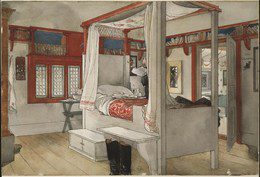
Fact 11: The Larssons Were Given A House in Sundborn, Sweden
Karin’s father gave them a small house in 1888 named Lilla Hyttnäs in Sundborn, just outside Falun in Dalarna, Sweden. This tiny timbered cottage was originally built in 1837. Carl and Karin decorated and furnished this little house according to their artistic taste and style.
Carl Larsson painted his family in this house, so the interior and the exterior of this little house are the most viewed and recognizable artistic homes in the world.
In speaking of this house and his paintings, it was said:
“Carl’s paintings and books have made Lilla Hyttnäs one of the world’s most familiar homes. But not only that. The quality of the light, Karin’s liberated gift for interior design and the lively family life as it is depicted in Carl’s beloved watercolours, has become almost synonymous with our picture of Sweden.
Carl larsson Garden – Sundborn
The house still looks the same as it did when Carl and Karin lived there and today’s visitor to Lilla Hyttnäs can almost hear the animated laughter of the children and catch the scent of the artist’s oil paints.”
You can see each room of the house’s photos by visiting the website Carl Larsson Garden – Sundborn by clicking here.
Fact 12: Karin Larsson Influenced Swedish Interior and Textile Design
Karin Larsson deserves much credit for changing the Swedish style into what it is today. At the time of Carl and Karin Larsson, many of the interiors of homes in Sweden were dark with heavy furniture.
Karin Larsson brought bright interiors with a blend of Swedish folk design influences. Her sense of style is depicted in Carl Larsson’s paintings.
In her new Swedish style, she removed curtains and placed furniture along the walls. She had practical rooms used by the family as a sofa in the corner for a nap as a dog lies down on a rug. Carl Larsson’s paintings and his home all have a sense of a house with style but is functional and well-lived.
The Victoria & Albert Museum in London in honoring Karin Larsson for her contribution to textile design, said:
“Karin’s textiles were absolutely original. Pre-modern in character they introduced a new abstract style in tapestry. Her bold compositions were executed in vibrant colours; her embroidery frequently used stylised plants. In black and white linen she reinterpreted Japanese motifs. Technically adventurous, she explored folk techniques and experimented with others. A good example of her bold weaving is the tapestry ”The Four Elements” that she composed in 1903 to be hung above the new sofa in the dining room.”
Victoria & Albert Museum
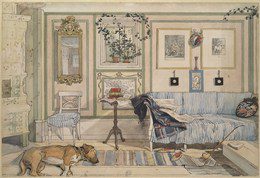
Fact 13: Carl and Karin Worked Together On Their Home Design
This easy kind of design that Sweden is now known for as being both functional and simple yet bright and airy was a new look during the time of Carl and Karin Larsson. When you look at Karin’s style that Carl Larsson painted, you can see a house where light and color were essential, and each part of the house had a function.
In 997, the Victoria and Albert Museum in London gave Karin Larsson some credit for her interior design of the Carl Larsson house. In speaking about Karin and Carl Larsson and how they worked together on the design of their home, they said:
“At Sundborn the Larssons developed an aesthetic partnership. He was effusive, covering the walls with foliage and flowers, she arranged the living flowers, but in her designs austere and often abstract. The colours of the interior seem to have been jointly decided. Their combined contributions created a perfect whole”
victoria & Albert museum
Fact 14: Carl Larsson’s Popularity Increased With The Colored Printing Press
In the 1890s, when color reproduction technology was starting to be widely used in the printing industry, Booner. a Swedish publisher, published a book written and illustrated by Carl Larsson. These books contained full-color reproductions of many of his watercolors. For the first time, many Swedes were able to see the colored reproductions of his actual paintings. These books were expensive, and due to the cost, the book distribution was limited.
Fact 15: His Books Became Very Successful
In 1909, printing colored books became more widely distributed, and the German publisher Karl Rober Langewiesche decided to publish Carl Larsson’s book. His books became almost overnight bestsellers.
Here is some information on this 1909 print run of his book:
- 40,000 copies were sold in 3 months.
- As of today, this same book has had over 40 print runs.
- Carl and Karin Larsson were overwhelmed by the book’s success; it was not something they expected.
Fact 16: Carl Larsson Considered His Most Important Work To Be In Public Spaces
Carl Larsson considered his most important work to be paintings he did as frescos in schools, museums, and other public buildings. The last important work like this that he did was the Midvinterblot (Midwinter Sacrifice) for the National Museum in Stockholm.
The Midvinterblot (Midwinter Sacrifice) was a 20 ft by 46 ft (6 Meter by 13 Meter) oil painting he completed in 1915. The painting was to be on a wall of the National Museum in Stockholm. Once the Midvinterblot (Midwinter Sacrifice) painting was completed, it was rejected by the museum’s board of directors even though the Museum already had several of Larsson’s frescos on its museum walls.
Fact 17: Carl Larsson was Bitter Over the Rejection of the Midvinterblot Painting
Larsson was very bitter over the rejection of the Midvinterblot painting. In his memoir called Jag. which was published after Larsson’s death, he said this about his bitterness over the Museum’s rejection of his Midvinterblot painting:
“The fate of Midvinterblot broke me! This I admit with subdued rage. Yet it was for the best – once again my intuition tells me that now – for this painting, with all its weaknesses, will be honoured with a far better place some day after I am gone”
Carl Larsson

Fact 18: Midvinterblot’s Controversy Continued for Years.
The controversy with the Midvinterblot painting continued for many years. In 1987 the National Museum was offered the painting for free because it would be placed on the empty wall in which it had been originally intended. The Museum refused this offer, so the painting was sold to the Japanese art collector Hiroshi Ishizuka.
In 1992, Hiroshi agreed to loan the painting to the museum for its major Carl Larsson exhibition. During this exhibition, it was hung where the painting was originally intended.
Public opinion changed the art experts’ view of the painting. Private donations were collected, and the museum purchased the painting from Hiroshi. In 1997, Midvinterblot finally returned home to Sweden and is now displayed in Carl Larsson originally intended for it. We must all believe that Carl Larsson is happy that his beloved MIdvinderblot painting has finally returned to the National Museum in Stockholm, Sweden.
Fact 19: Paintings of His Family Are His Life’s Work
Despite his disappointment with the Midvinterblot painting and its rejection by the National Museum, Carl Larsson understood that his home and family’s paintings were some of his most important life work.
in his memoirs, Carl Larsson said this about his paintings of his wife, children, and their home:
“(These pictures) became the most immediate and lasting part of my life’s work. For these pictures are of course a very genuine expression of my personality, of my deepest feelings, of all my limitless love for my wife and children.”
carl larsson
Fact 20: Carl Larsson Suffered From Depression and Other Medical Problems
In his later life, Carl Larsson suffered from bouts of depression. Also, while working on this Midvinterblot painting, he experienced eye problems and frequent headaches.
In early January 1919, he suffered from a stroke and knew he would soon die. He spent the rest of his time left working on his memoirs. He died at the end of January 1919 and is buried in the cemetery of the Sundborn Church near his beloved home.
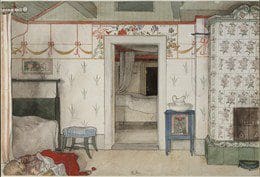
Fact 21: His Work Is Representative of the Arts and Crafts Movement.
Carl Larsson’s work is representative of the Arts and Crafts Movement. To find out more about the Arts and Crafts Movement, you can read our blog, What Are The Characteristics Of The Arts And Crafts Movement? by clicking here.
Fact 22: You Can Visit the Carl and Karin Larsson Home
If you travel to Sweden, do not miss out on visiting the Carl and Karin Larsson family home in Sundborn. Sweden. The house is in a lovely setting with a garden, and you can see firsthand where many of Carl Larsson’s paintings were painted.
Above the entrance is to the home is a sign that says, “Welcome to the Home of Carl Larsson and His Spouse.” This invitation from the artist and his wife Karin is an invitation for us to come into his home and to be part of their lives.
You can find out more about how to visit the Larsson Family Home and Garden by clicking here.
Carl Larsson painted the scenes of his home and family over 100 years ago. His paintings draw us into his home, life, and family still resonate with us today as they did over 100 years ago. He is one artist whose artwork has passed the relevance test of time.
Deep Dive Podcast
Check out our Deep Dive Podcast to learn more.
Anita Louise Art is dedicated to art education, great artists, and inspiring others to find and create their art. We love art that uplifts and inspires. #ArtToMakeYouSmile! #ArtToMakeYouHappy!
If you want to see any of my art, you can find out more by clicking here. If you are interested in what inspires me and my paintings, you can discover more by clicking here.
We have a free newsletter and would love you to be part of our community; you can subscribe to the newsletter by clicking here. If you have any questions, I would be happy to talk to you anytime. You can reach me, Anita, by clicking here.
Subscribe to our Anita Louise Art YouTube Channel with great videos and information by clicking here.
Join us for our podcast “5 Minutes With Art.” Spend 5 minutes a week with us to discover and learn about great art and artists. You can find out more about our podcast by clicking here.
Frequently Asked Questions About the Swedish Artist Carl Larsson
Who is Carl Larsson?
Carl Larsson was a Swedish artist who is best known for his watercolor paintings of idyllic family life in the late 19th and early 20th centuries
When was Carl Larsson born?
Carl Larsson was born on May 28, 1853.
Where was Carl Larsson born?
Carl Larsson was born in Gamla stan, the old town of Stockholm, Sweden.
What kind of art did Carl Larsson create?
Carl Larsson primarily created watercolor paintings of everyday life, particularly family life, that was inspired by the Swedish countryside and traditional Swedish culture.
What was Carl Larsson’s most famous painting?
Carl Larsson’s most famous painting is arguable “Midvinterblot,” which depicts a pagan ritual in pre-Christian Sweden.
What was Carl Larsson’s family like?
Carl Larsson’s family was a source of inspiration for much of his art, particularly his wife Karin and their eight children.
Was Carl Larsson famous during his lifetime?
Yes, Carl Larsson was quite famous during his lifetime and was recognized as one of Sweden’s foremost artists.
What is the legacy of Carl Larsson’s work?
Carl Larsson’s work is considered a significant contribution to the Swedish cultural heritage and has had a lasting impact on the visual representation of Swedish family life.
When did Carl Larsson die?
Carl Larsson died on January 22, 1919.
Where is Carl Larsson buried?
Carl Larsson is buried in Sundborn Cemetery, near his home and museum.
Did Carl Larsson’s art have an impact outside of Sweden?
Yes, Carl Larsson’s art was well-known outside of Sweden, particularly in Germany and the United States.
How did Carl Larsson’s art change over time?
Carl Larsson’s art became increasingly influenced by the Arts and Crafts movement over time, with a focus on decorative elements and a more stylized approach to composition.
Related Questions
Who Was Carl Heinrich Bloch?
One of Denmark’s greatest artists, Carl Bloch, almost did not become an artist. His parents wanted him to join the Navy, but he was consumed with art and proved early in life to be artistically gifted. Throughout his life, he painted many important paintings. One of his most important art commissions was to paint 23 scenes from the life of Christ at the Frederiksberg Castle in Denmark. Later in life, he became a very skilled printmaker. Carl Bloch was married and had eight children. Both Carl and his wife Alma died quite young.
You can read our blog on 18 Facts About The Artist Carl Heinrich Bloch (1834 – 1890) by clicking here.
Who Was The Dutch Artist Henriette Ronner-Knip?
Henriette came from a family of artists. At an early age, she became in charge of the family’s finances and other legal obligations, so she started to paint. She sold her first painting at the age of 15-year-old. Later, when she was married, Her husband became her manager, and Henriette continued to paint. She is famous for her many wonderful paintings of cats and dogs. She chooses to paint dogs and cats as subject matter because, during the Victorian era, having a pet in your household was popular.
You can read more about her by reading our blog Henriette Ronner-Knip (1821-1909), Painter of Cats & Dogs, by clicking here.

